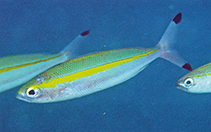| Family: |
Caesionidae (Fusiliers), subfamily: Caesioninae |
| Max. size: |
21 cm TL (male/unsexed) |
| Environment: |
reef-associated; marine; depth range 2 - 25 m, non-migratory |
| Distribution: |
Indo-West Pacific: Red Sea and East Africa to eastern Australia. |
| Diagnosis: |
Dorsal spines (total): 10-11; Dorsal soft rays (total): 14-16; Anal spines: 3-3; Anal soft rays: 11-13. Body light blue to brownish dorsally, white to pinkish ventrally. Broad yellow stripe just under lateral line (Ref. 48636). 4-5 cheek scales; 21-27 predorsal scales; scaled dorsal and anal fins. Upper peduncular scale rows usually 11 (11-13); lower peduncular scale rows usually 15 (14-17). Ventrolateral surface of basioccipital with a broad process for insertion of Baudelot's ligament. Post maxillary with 2 processes; posterior end of maxilla tapered. Small conical teeth in jaws, voter and palatines (Ref. 1723). Head length 3.0-3.5 in SL; body depth 3.3-4.6 in SL (Ref. 90102). |
| Biology: |
Ranges widely around coral reefs. Found in schools. Feeds on zooplankton in large midwater aggregations. Oviparous, with numerous, small pelagic eggs (Ref. 402). Also caught by drive-in nets. Valuable tuna baitfish. |
| IUCN Red List Status: |
Least Concern (LC); Date assessed: 06 March 2015 Ref. (130435)
|
| Threat to humans: |
harmless |
Source and more info: www.fishbase.org. For personal, classroom, and other internal use only. Not for publication.
